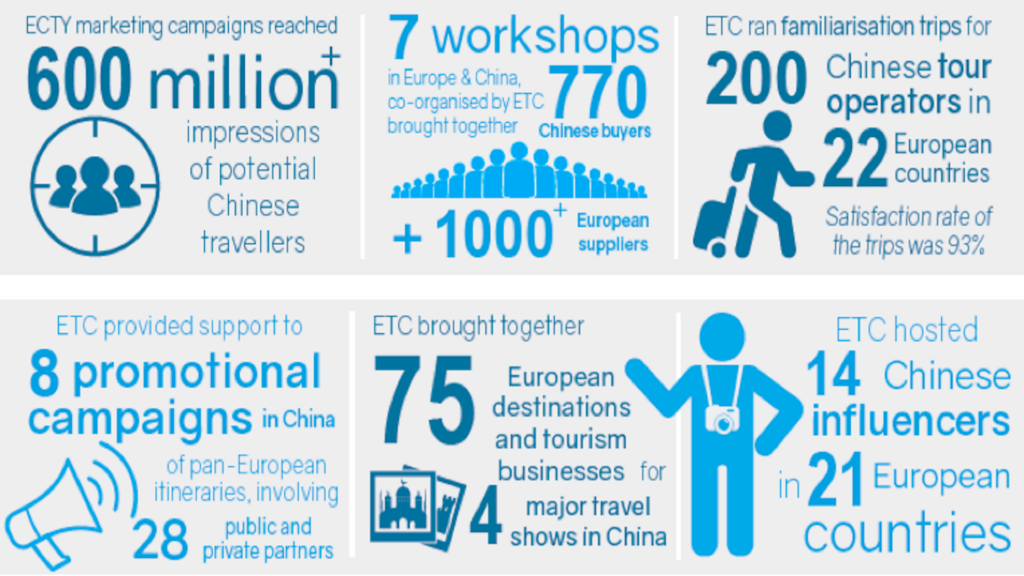The story of Chinese tourists in Europe over the past decade is one of sustained success on an unprecedented scale. No market outside Asia has profited more from Chinese sojourns abroad than Europe. In 2018, Europe saw 6 million Chinese tourists stay 30 million nights and spend an estimated $16.5 billion — for context, the Americas received less than half of the number of tourists.
Initial waves of Chinese tourists may have concentrated on Europe’s most iconic landmarks — turning selfies atop the Eiffel Tower and visits to the Colosseum into essential social currency for a newly rich generation — but Europe has shown a remarkable capacity to diversity its appeal to China, steering travelers towards Croatia’s pristine coastline, city escapes in Helsinki, and the wilds of Ireland.
The European Travel Commission (ETC) has proved pivotal in the trajectory of this story, helping the continent’s tourism stakeholders connect with and serve an ever-changing market. Now, with Europe reopening its borders to China on July 1, understanding the world’s most lucrative travel market is more important than ever.
Jing Travel connected with Eduardo Santander, Executive Director of the ETC, to better understand the steps the ETC is taking in this moment and the future of Chinese travel in Europe.
These are uncertain times, what information do European tourism stakeholders need to effectively promote themselves in China?
This crisis is unprecedented, and there are many unknowns which European NTOs and DMOs need to figure out in order to effectively reach out to Chinese travellers, such as: When will Chinese travellers feel comfortable resuming travel to Europe? Will their travel preferences and consumption patterns change? What are their criteria for the selection of a holiday destination in Europe? What are Europe’s main competitors?

The ETC reported 5.1 percent year-on-year increase in Chinese arrivals in EU destinations in 2018. Image: ETC
Pre-COVID-19, what have proved the most effective ways for ETC to support European stakeholders in the China market?
We have held several B2B events such as matchmaking events, trade fairs, and familiarization trips providing opportunities for networking and facilitating direct and face-to-face contacts between local suppliers and Chinese buyers.
We are proud of the 2018 EU-China Tourism Year (ECTY), which presented an opportunity to attract more Chinese travellers to European destinations off the beaten path. ETC also rolled out a 16-month programme of cooperative marketing activities designed to increase the appetite of Chinese Free Independent Travellers (FITs) for discovering new European destinations.
As you mentioned, Chinese Free Independent Travellers are on the rise with many predict the demise of the Chinese group travel, however, given the market size and potential growth, group travel will not simply disappear. How can destinations strike a balance?
We expect the preference for big group tours might actually fall post-COVID-19, with self-guided and self-drive tours being on the rise. No destination will close its door to groups, especially after the COVID-19 crisis, but the promotion and marketing strategy adopted by the destinations will influence the type of travellers that want to visit.
ETC’s strategy is to focus on niche travel and as a result on FITs. These travellers spend more time at the destination and will eventually spread benefits more broadly across the economy, thus resulting in a more sustainable form of tourism emerging.
We believe Free Independent Travel is booming and will continue to do so post-COVID-19. We expect that FIT travel will recover faster, and European destinations need to adapt their offer according to what independent travellers are looking for.
How will ETC support this shift towards Chinese Free Independent Travellers?
ETC’s Horizon 2022 marketing strategy has shifted from a geographically based segmentation to a cross-border and passion-based approach, bundled in specific themes. These niche markets are still sizable but are better aligned with the specifics that Europe has to offer and are easier to connect with at an emotional level. For us now passion comes first, destination second.
Beyond the type of Chinese traveler, there’s been a worrying uptick in anti-China sentiment, how can stakeholders demonstrate they are genuinely welcoming to Chinese tourists?
Continuous communication with Chinese stakeholders and travellers through online presences, such as webinars, is one way of demonstrating welcome for Chinese travelers.
Other methods include working together with local providers in China to streamline processes, focusing on the needs of Chinese travellers and their request for safety and ease of travel, and upgrading skills and knowledge related to the welcoming of Chinese travellers, such as hospitality standards for Chinese travellers or mobile solutions.
In the long term, how do you see the volume and type of Chinese tourist traveling to Europe changing in 2021 and beyond?
As we move towards 2024, the number of Chinese tourist arrivals to Europe is expected to grow annually by 2.6%. This is a significant slowdown compared to the annual growth rates that we expected before the COVID-19 pandemic, which stood at 7.1%.
We expect an increase of Free Independent Travellers (FITs), more independent and self-guided trips, and a shift towards smaller groups rather than large group tours.




